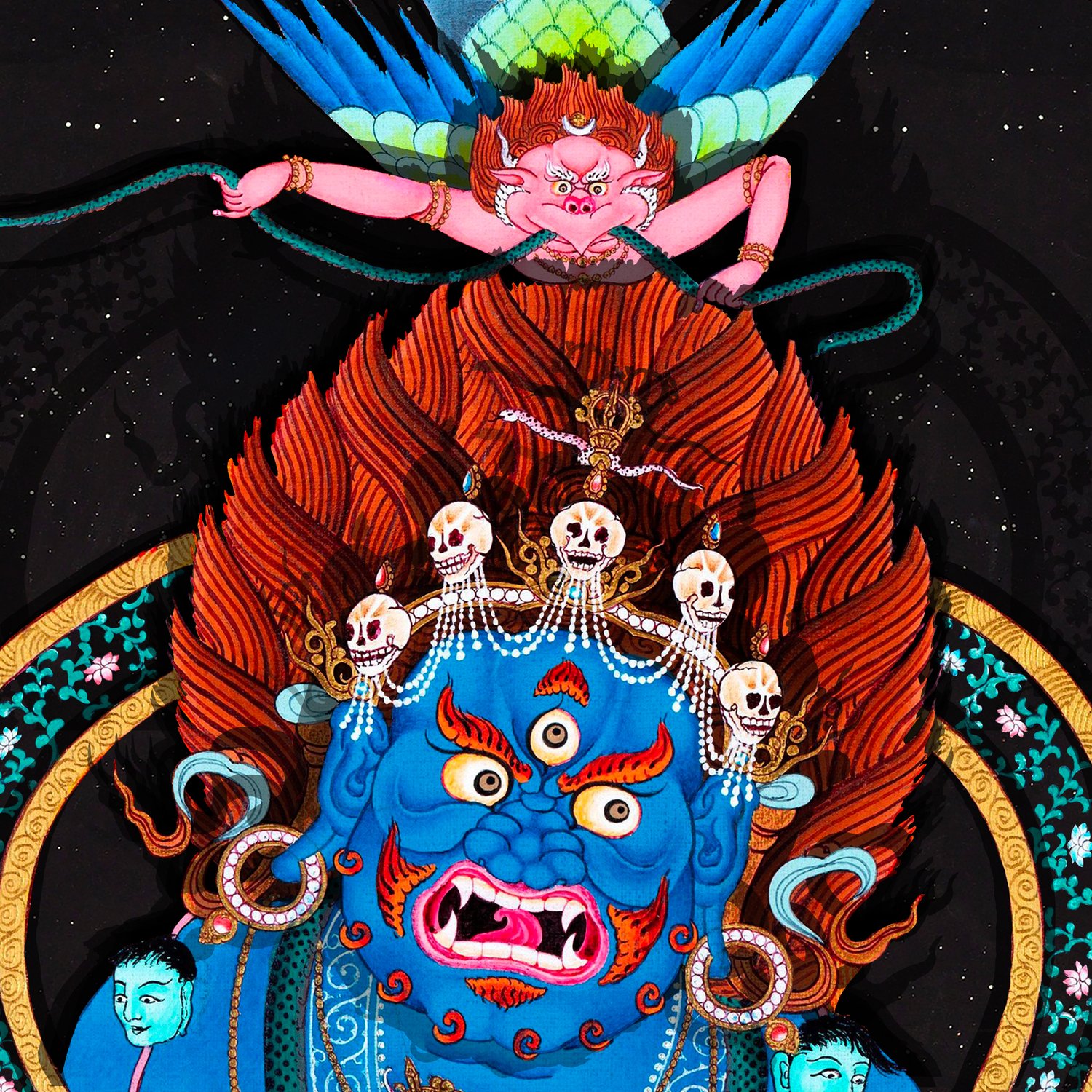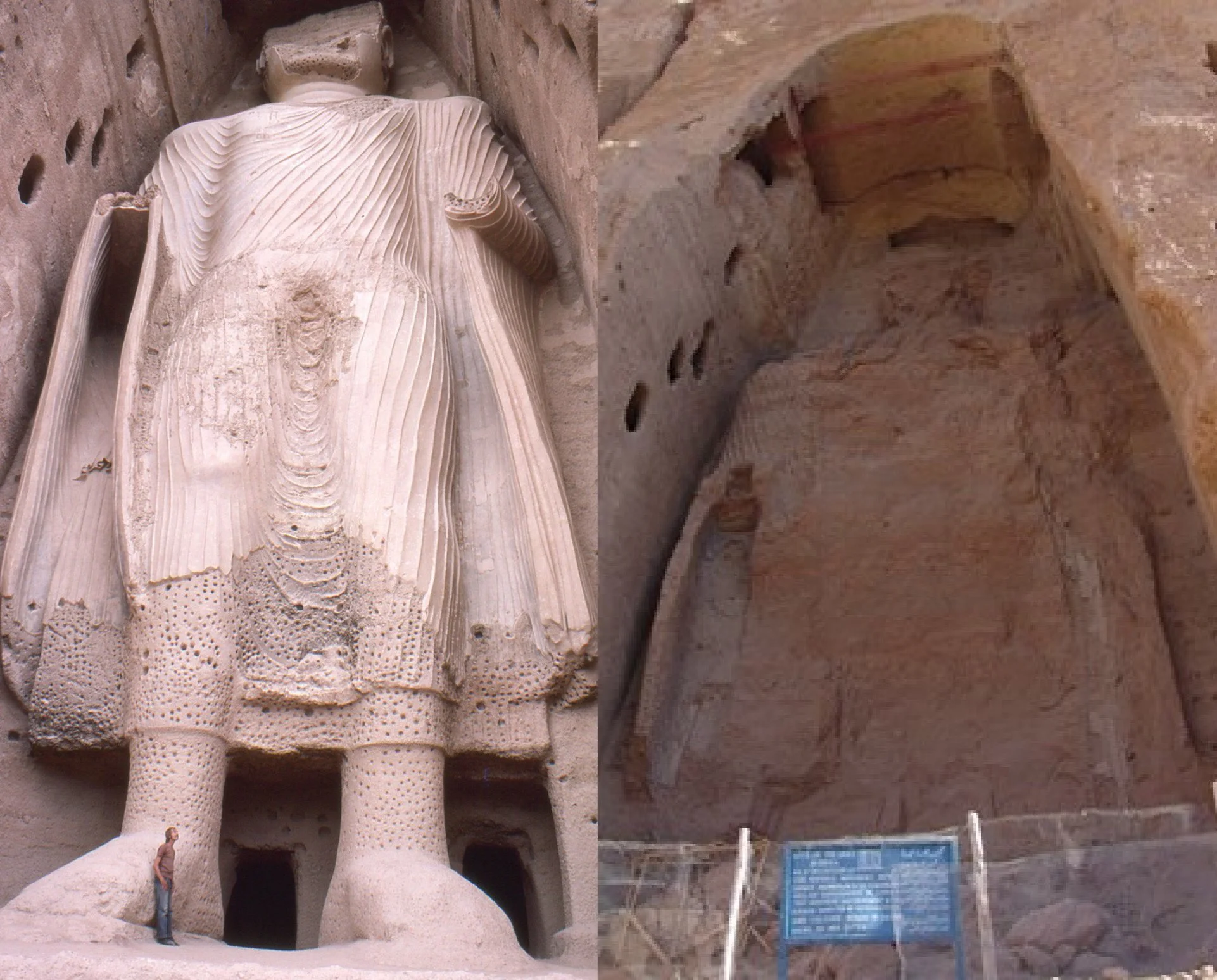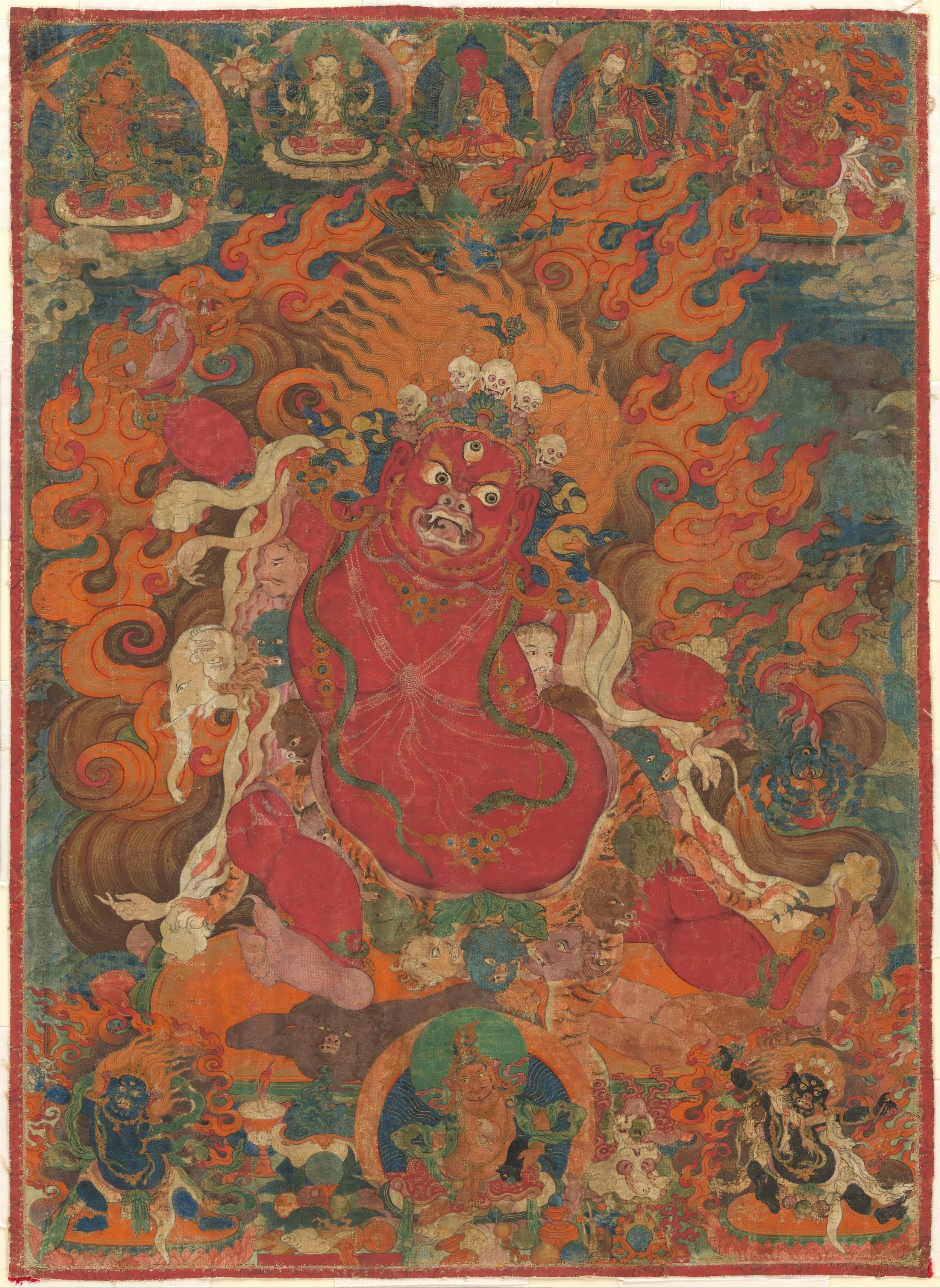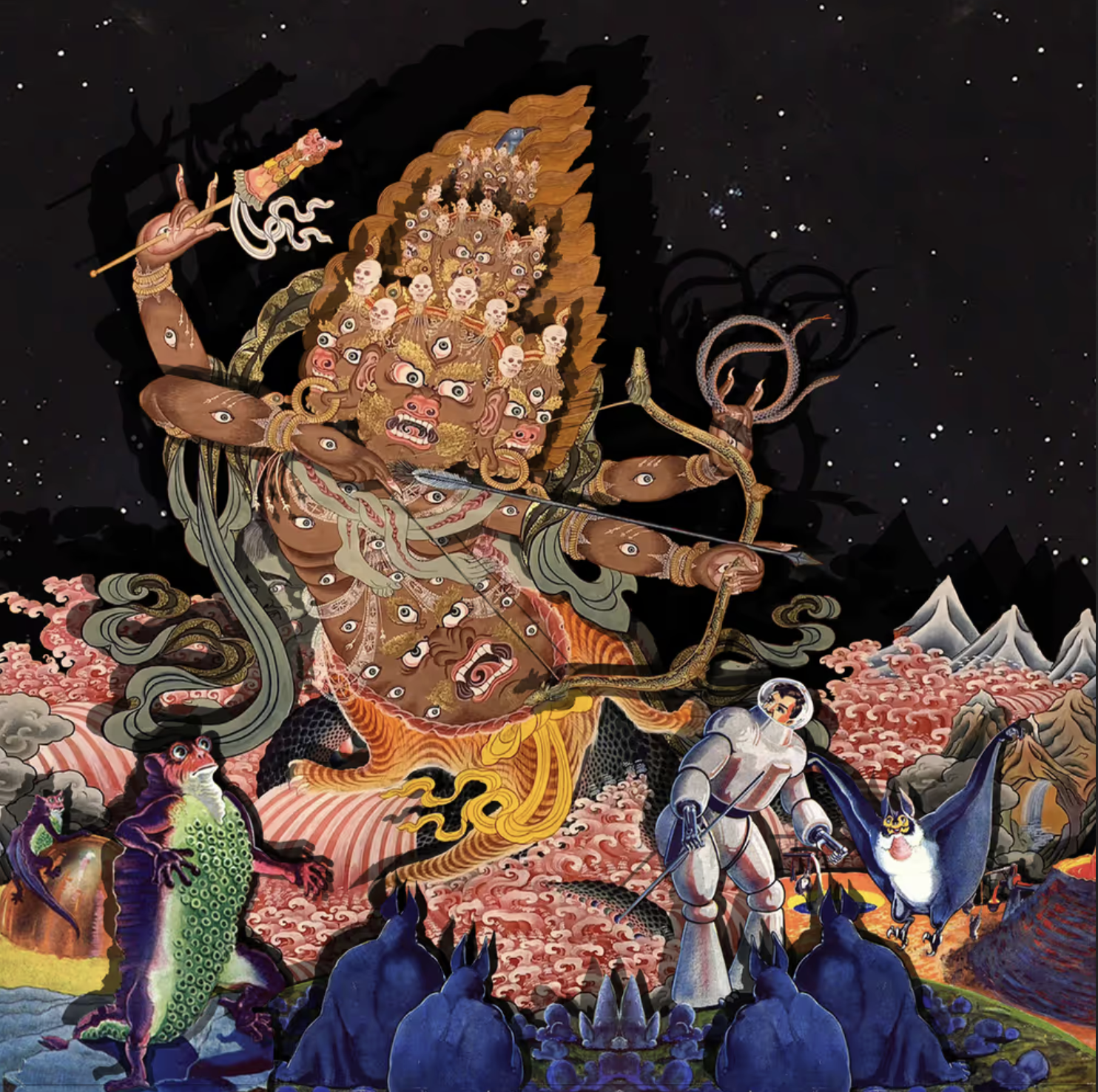Immutable Heritage: Countering a History of Censorship with Art on the Blockchain
In March of 2001, the world watched helplessly as the Taliban regime in Afghanistan turned artillery on two colossal statues of the Buddha carved into a cliffside. For 1,500 years, the Bamiyan Buddhas had stood serene witness to the passage of empires, the traffic of the Silk Road, and the prayers of countless generations. In a matter of days, they were reduced to dust and memory, their empty niches left as monumental scars in the rock.
This act of violent iconoclasm was not an isolated event. It was the 21st-century echo of a long and brutal history.
For as long as Buddhist art has been created, it has been a target. Celebrated globally as a symbol of peace, its material forms—statues, scriptures, and monasteries—have been systematically burned, shattered, and banned by emperors, conquerors, and modern authoritarian states. This is not merely the destruction of objects; it is the deliberate erasure of cultural provenance, an attempt to sever a people from their artistic and spiritual lineage.
But what if art could be made permanent? What if a work's existence and authenticity could be guaranteed, placed forever beyond the reach of the censor's fire or the dictator's decree?
This question is no longer hypothetical. The same digital revolution that has reshaped our world now offers a revolutionary tool for cultural preservation. By inscribing art onto the blockchain, we can create an immutable, decentralized, and permanent record of heritage. For the modern art patron, this presents a profound opportunity: to move beyond passive appreciation and become an active participant in safeguarding a legacy. This is the story of how the world's oldest threat to art is being met by its newest technology, and how the act of collecting can become a radical act of preservation.
Before/After: 55-metre (180 ft) "Western Buddha" - Bamiyan Afghanistan
Before/After: 38-metre (125 ft) "Eastern Buddha" - Bamiyan Afghanistan
The Age of Empire: Co-opting a Faith
Censorship is not always an act of destruction; sometimes, it is an act of corruption. The most insidious form of suppression does not always involve smashing statues, but rather twisting the ideals they represent. No period in modern history illustrates this more clearly than the rise of Imperial Japan in the years leading up to World War II. Here, the Japanese state undertook a systematic campaign not to erase Buddhism, but to censor its core teachings of peace and compassion, reframing it as a tool for nationalist fervor and military expansion.
Imperial Japanese Commission to the Panama-Pacific International Exposition - Hōryūji Temple
During the Meiji Restoration and the subsequent rise of militarism, the government promoted State Shinto as the official ideology, emphasizing the divinity of the Emperor and the glory of the Japanese race. Buddhism, with its deep roots in Japanese culture, could not be simply eliminated. Instead, it was subordinated and forced into compliance.
This "spiritual mobilization" took several forms:
Doctrinal Censorship: Zen masters and scholars were pressured to reinterpret Buddhist concepts to align with the state's agenda. The idea of "no-self" was twisted from a path to enlightenment into a call for absolute self-sacrifice for the Emperor. The concept of compassionate action was reframed as the "compassionate bayonet," arguing that conquest was a merciful act to liberate Asia from Western colonialism.
Forced Compliance: Temples were required to display portraits of the Emperor and Empress, and monks were compelled to preach pro-war sermons. Those who resisted or preached peace were branded as traitors, arrested, and their teachings censored.
Appropriation of Art: The serene and meditative aesthetics of Buddhist art were co-opted for propaganda. The image of the disciplined samurai, often linked to Zen practice, was used as the ideal for the modern Japanese soldier.
This period demonstrates a crucial evolution in censorship. The threat was not the physical destruction of art, but the hollowing out of its meaning. The Japanese government understood that a statue is only a symbol; by controlling the ideas behind the symbol, they could turn a religion of peace into an engine of war. This subtle, systemic corruption is, in many ways, more dangerous than outright destruction because it preserves the art's form while completely erasing its soul.
The Modern Authoritarian: Annihilating a People's Art
If the censorship in Imperial Japan was a subtle poison that hollowed out the meaning of art, the Chinese Communist occupation of Tibet was a sledgehammer. Following the invasion in 1950 and culminating in the Cultural Revolution (1966-1976), the goal was not to co-opt Tibetan Buddhism, but to achieve its total annihilation. This campaign represented one of the most catastrophic episodes of artistic and cultural destruction in modern history.
Tibetan Thangka Painting from the 1700s
The very essence of Tibetan culture is interwoven with its unique artistic traditions, which serve as both devotional tools and visual records of spiritual knowledge. The assault on Tibet was therefore an assault on its art:
The Loss of Thangkas and Murals: Monasteries were not just places of worship; they were living museums. Their walls were covered in magnificent murals, some centuries old, depicting the life of the Buddha and complex cosmological maps. Inside, they held thousands of thangkas—intricate scroll paintings on silk or cotton, meticulously created using mineral pigments and ground gold. During the Cultural Revolution, it is estimated that over 6,000 monasteries were destroyed. Monks were forced to tear down their own murals, and countless thangkas were burned, used as shoe soles, or sold as curios. The sacred geometry, iconographic knowledge, and artistic techniques passed down through generations were erased with them.
Tree of Life Thangka from the 1700s
The Melting of Statues: Tibetan sculpture, known as jindrak, involved the creation of breathtaking statues from bronze, silver, and gold, often inlaid with precious gems. These were not mere decorations but objects of veneration, believed to house the spirit of the deity depicted. Red Guards systematically shattered these statues or melted them down for their raw materials, destroying an artistic and metallurgical tradition perfected over a thousand years.
The Burning of Scripture: Tibetan calligraphy is a high art form, and its sacred texts, or pechas, were often works of immense beauty, with pages of handmade paper inscribed with gold ink and bound in silk. The destruction of monastic libraries was not just a loss of religious doctrine but a bonfire of irreplaceable works of literary and calligraphic art.
This cultural crisis is what sparked the global Free Tibet movement. While awareness had been growing for decades, the cause exploded into Western consciousness in the 1990s. Fueled by the charismatic leadership of the exiled Dalai Lama and a post-Cold War focus on human rights, the movement became a cultural phenomenon. At its heart were the Tibetan Freedom Concerts, massive music festivals organized by artists like the Beastie Boys, which brought the plight of Tibet to an entire generation. For a time, the "Free Tibet" sticker on a guitar case and the sight of monks creating sand mandalas at Lollapalooza became powerful symbols of protest, using the art of Western music to decry the destruction of Tibetan art.
But did it work? The answer is complex. The movement was immensely successful in raising global awareness. It turned the occupation of Tibet into a universally recognized human rights issue and placed significant public pressure on China. However, this cultural momentum failed to translate into lasting political change. As China's economic power grew, Western governments and corporations prioritized trade over sanctions, and the political will to confront Beijing on Tibet faded.
Today, the issue is more critical than ever, though it has evolved beyond the sledgehammer of the Cultural Revolution. The Chinese government now employs a sophisticated system of "soft" cultural erasure. This includes intense digital surveillance that stifles any artistic or religious expression outside of state control, and a system of mandatory boarding schools designed to separate Tibetan children from their language, families, and traditions. The threat to Tibetan art is no longer just a soldier with a torch; it is a state-controlled curriculum and a firewall that slowly strangles a culture's ability to create, worship, and pass its unique artistic lineage to the next generation.
Censorship at Home: The American Story
The history of censorship is not something that happens only in distant empires or authoritarian states; it is written into the pages of American history. For many, the most jarring chapter is Executive Order 9066. Signed in 1942, it authorized the forced removal and incarceration of over 120,000 people of Japanese ancestry, the majority of whom were American citizens. While framed as a matter of national security, it was a profound act of racial and religious censorship, and at its heart was the perception of Buddhism as an alien, un-American faith.
Young Japanese American forced relocation with his pulp comic books.
In the eyes of the state, the Buddhist faith of most Japanese Americans was not a private spiritual practice but proof of their inherent foreignness and presumed loyalty to Imperial Japan. FBI agents raided temples, confiscated religious texts and art, and arrested priests. This was not just a violation of civil liberties; it was the targeted suppression of a culture's artistic and spiritual heart.
The artistic loss was immediate and devastating:
The Abandonment of Sacred Art: Temples up and down the West Coast were forced to close. Intricately carved altars (butsudan), gilded statues, bronze bells, and precious scrolls were locked away, left to an uncertain fate. Many of these sacred objects, some carried by immigrant families for generations, were lost forever—vandalized, looted, or sold off as exotic trinkets. The physical anchors of a community’s artistic and spiritual life were severed.
Art Under Duress: Inside the stark, barbed-wire enclosures of the concentration camps, the incarcerated community displayed incredible resilience. They created art from nothing, fashioning sculptures from desert wood, painting on scraps of paper, and constructing beautiful gardens in the dust.
Japanese American internment camp - Manzanar CA
This historical injustice is not a closed chapter; it is a living legacy. The same undercurrent of xenophobia that classified Buddhist Americans as a threat in the 1940s continues to surface in modern America, though its methods have evolved.
The most visceral threat is the resurgence of overt hate. In the wake of the COVID-19 pandemic, a surge in anti-Asian violence saw Buddhist temples across the country targeted. In 2021, the Higashi Honganji Buddhist Temple in Los Angeles—a historic institution founded in 1904—was vandalized and partially burned. This was not an isolated incident. From Arkansas to Texas, temples have been desecrated, their windows smashed and sacred statues defaced. These acts of violence are a direct continuation of the legacy of Executive Order 9066, physically attacking the sacred spaces of a community still perceived as "foreign."
Beyond physical violence and systemic obstruction lies a more insidious threat, one perfectly suited to the modern West: censorship by consumerism. In the vast marketplace of wellness and home decor, Buddhist art and symbols are relentlessly decontextualized, stripped of their profound spiritual meaning, and commodified into lifestyle accessories. This isn't an act of overt hostility, but its effect is a devastating form of cultural erasure.
The process is always the same. A sacred object, the product of a rich artistic and contemplative lineage, is reduced to a single, marketable aesthetic: "calm."
A Buddha head, traditionally an object of veneration representing the enlightened mind, is severed from its body—an act considered deeply disrespectful in many traditions—and sold as a planter or a chic bookend. Its function is no longer to inspire contemplation of the Four Noble Truths, but to match a neutral color palette.
Mandalas, which are intricate cosmological maps of the universe and tools for advanced meditation, are mass-printed onto yoga leggings and beach towels. Their sacred geometry, meant to be a focal point for internal transformation, becomes a mere pattern.
Even the core philosophy is sanitized for sale. The First Noble Truth—that life inherently involves suffering (dukkha)—is replaced by the vapid slogan of "Good Vibes Only."
This trivialization is a powerful form of "soft censorship" because it floods the cultural landscape with a hollow caricature. It effectively censors the authentic tradition by making the shallow, commercialized version ubiquitous. For the art patron who understands that an object's value is tied to its provenance, authenticity, and meaning, this is a profound loss. It's a slow-motion hollowing out of an entire artistic and spiritual legacy, not with a sledgehammer, but with a price tag.
Conclusion: Forging a Permanent Record on the Blockchain
From the sledgehammer of the Taliban in Afghanistan to the state-controlled curriculum in Tibet, from the co-opted temples of Imperial Japan to the commodified Buddhas in the American wellness market, the threat to Buddhist art has been relentless and adaptive. The methods change—from overt destruction to insidious corruption—but the goal remains the same: to sever art from its meaning, to break the chain of provenance, and to erase a culture's soul. For centuries, this assault on physical and intellectual heritage has been largely unanswerable. Stone can be shattered, scrolls can be burned, and meaning can be hollowed out.
For the first time in history, a technology has emerged that can meet this ancient threat.
The blockchain offers a revolutionary answer to the fundamental problem of censorship. By minting an artwork as a unique token on a distributed ledger, we are not merely creating a digital collectible; we are forging a new kind of immutable heritage.
It is a direct counter to physical destruction. A decentralized record, distributed across thousands of computers worldwide, cannot be burned or bombed into oblivion. The empty niches of Bamiyan stand as a testament to the vulnerability of physical art; the blockchain offers a permanent digital witness.
It is a bulwark against state control and corruption. A public, transparent ledger cannot be altered by any single government or authority. The state cannot secretly change the art's history, meaning, or ownership. The provenance is clear, permanent, and public.
It is an antidote to trivialization and erasure. The token itself can be permanently linked to the art's story—its history, its spiritual significance, and the artist's intent. It reunites the image with its soul, ensuring it can never again be reduced to a meaningless decoration.
For the modern art patron, this transforms the act of collecting. It is no longer a passive acquisition but an active participation in preservation. To collect this art is to become a custodian of its legacy, funding the continuation of a tradition and holding a piece of its uncensorable future. It is an opportunity to become a crucial link in a chain of provenance that history has repeatedly tried to break.
This is the new frontier of cultural preservation. By wedding one of the world's most profound artistic traditions to its most resilient technology, we can ensure that this legacy will not be lost to the vagaries of history, but will instead be secured for generations to come.
"Adventure" digital collage 2021 - Paper Buddha









